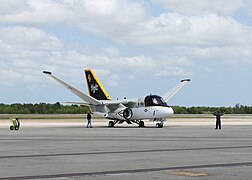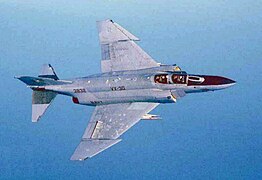
The Lockheed S-3 Viking is a four-crew, twin-engine turbofan-powered jet aircraft designed and produced by the American aerospace manufacturer Lockheed Corporation. Because of its characteristic sound, it was nicknamed the "War Hoover" after the vacuum cleaner brand.

The Lockheed P-3 Orion is a four-engined, turboprop anti-submarine and maritime surveillance aircraft developed for the United States Navy and introduced in the 1960s. Lockheed based it on the L-188 Electra commercial airliner; it is easily distinguished from the Electra by its distinctive tail stinger or "MAD" boom, used for the magnetic anomaly detection (MAD) of submarines.

The Douglas A-3 Skywarrior is a jet-powered strategic bomber that was developed and produced by the Douglas Aircraft Company. It was designed by Douglas on behalf of the United States Navy, which sought a carrier-capable strategic bomber. During July 1949, Douglas was awarded the contract to produce its design, having bested eight other aircraft companies' submissions. Unlike rival designs, which had aimed for a 100,000 lb (45,000 kg) maximum take-off weight, the Skywarrior was developed for a 68,000 lb (31,000 kg) take-off weight, facilitating its use from the navy's existing Midway-class aircraft carriers. Large portions of the aircraft were produced by the Westinghouse Electric Corporation, including its early Westinghouse J40 turbojet engines, which failed to meet promises and were replaced by the rival Pratt & Whitney J57 engine by mid-1953. On 28 October 1952, the prototype XA3D-1 performed the type's maiden flight.

The Boeing P-8 Poseidon is an American maritime patrol and reconnaissance aircraft developed and produced by Boeing Defense, Space & Security, and derived from the civilian Boeing 737-800. It was developed for the United States Navy (USN).
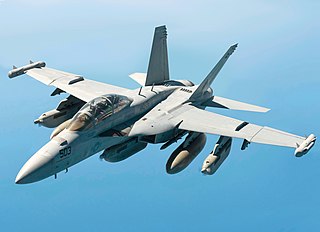
The Boeing EA-18G Growler is an American carrier-based electronic warfare aircraft, a specialized version of the two-seat F/A-18F Super Hornet. The EA-18G replaced the Northrop Grumman EA-6B Prowlers in service with the United States Navy. The Growler's electronic warfare capability is primarily provided by Northrop Grumman. The EA-18G began production in 2007 and entered operational service with the US Navy in late 2009. Australia has also purchased thirteen EA-18Gs, which entered service with the Royal Australian Air Force in 2017.

The Northrop Grumman MQ-4C Triton is an American high-altitude long endurance unmanned aerial vehicle (UAV) under development for the United States Navy as a surveillance aircraft. Together with its associated ground control station, it is an unmanned aircraft system (UAS). Developed under the Broad Area Maritime Surveillance (BAMS) program, the system is intended to provide real-time intelligence, surveillance and reconnaissance missions (ISR) over vast ocean and coastal regions, continuous maritime surveillance, conduct search and rescue missions, and to complement the Boeing P-8 Poseidon maritime patrol aircraft.

Pacific Missile Test Center (PMTC) is the former name of the current Naval Air Warfare Center, Weapons Division. The name of the center was the Naval Air Missile Test Center prior to PMTC. It is located at Naval Base Ventura County/Naval Air Station Point Mugu in Ventura County, California. The nearest city to the installation is Oxnard.
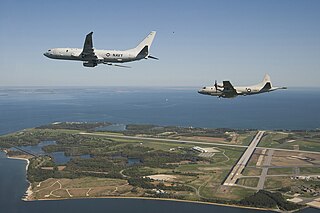
Naval Air Station Patuxent River, also known as NAS Pax River, is a United States naval air station located in St. Mary’s County, Maryland, on the Chesapeake Bay near the mouth of the Patuxent River.

Naval Base Ventura County (NBVC) is a United States Navy base in Ventura County, California. Formed by the merger of NAS Point Mugu and CBC Port Hueneme, NBVC is a diverse installation composed of three main locations — Point Mugu, Port Hueneme, and San Nicolas Island. The base serves as an all-in-one mobilization site, deep water port, railhead, and airfield. NBVC supports more than 100 tenant commands with a base population of more than 19,000 personnel, making it the largest employer in Ventura County.
VX-4, Air Test and Evaluation Squadron Four,, commonly referred to by its nickname of The Evaluators, was a United States Navy air test and evaluation squadron based at Naval Air Station Point Mugu, California. Their tail code was XF, and they flew the McDonnell Douglas F-4 Phantom, Grumman F-14 Tomcat and the McDonnell Douglas F/A-18 Hornet until their disestablishment in 1994.
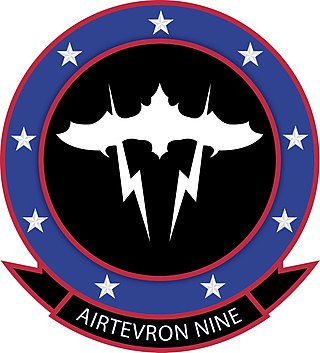
Air Test and Evaluation Squadron Nine is a United States Navy air test and evaluation squadron based at Naval Air Weapons Station China Lake, California. Using the tail code XE, the squadron operates F/A-18E/F Super Hornets and EA-18G Growlers.

The Operational Test and Evaluation Force (OPTEVFOR) serves as an independent and objective agency within the United States Navy for the operational testing and evaluation (OT&E) of naval aviation, surface warfare, submarine warfare, C4I, cryptologic, and space systems in support Navy and U.S. Department of Defense acquisition programs.
Naval Air Warfare Centers are research organizations within Naval Air Systems Command. The centers are grouped within the following divisions:

VX-20, Air Test and Evaluation Squadron Twenty, is a United States Navy air test and evaluation squadron based at Naval Air Station Patuxent River, Maryland.

Air Development Squadron Six was a United States Navy Air Development Squadron based at McMurdo Station, Antarctica. Established at Naval Air Station Patuxent River, Maryland on 17 January 1955, the squadron's mission was to conduct operations in support of Operation Deep Freeze, the operational component of the United States Antarctic Program.

Naval Air Station Point Mugu was a United States naval air station near Oxnard, California, which operated as an independent base from 1941 to 2000, when it merged with nearby Naval Construction Battalion Center Port Hueneme to form Naval Base Ventura County.

VP-60 was a Patrol Squadron of the U.S. Navy Reserve, based at NAS Glenview, Illinois. Its nickname was the Cobras. The squadron was established on 1 November 1970, and disestablished on 1 September 1994.

The Boeing MQ-25 Stingray is an aerial refueling drone that resulted from the Carrier-Based Aerial-Refueling System (CBARS) program, which grew out of the earlier Unmanned Carrier-Launched Airborne Surveillance and Strike (UCLASS) program. The MQ-25 first flew on 19 September 2019.
VX-1, Air Test and Evaluation Squadron One, is a United States Navy air test and evaluation squadron based at Naval Air Station Patuxent River, Maryland.

